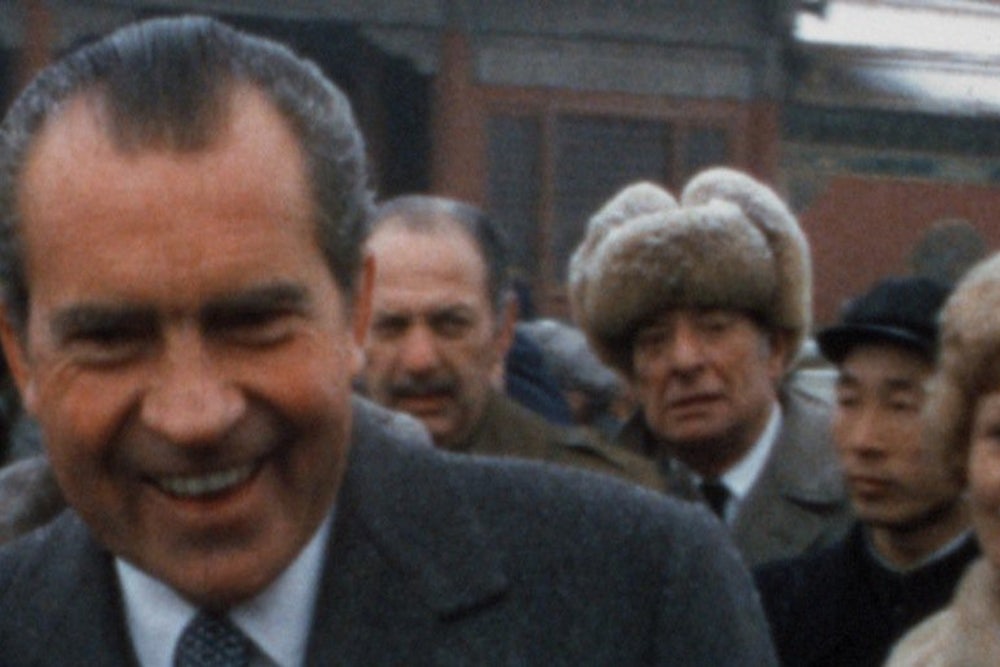Our Nixon is the title of a documentary presented by CNN and some non-political friends, which—again with an implying title—seems set to give us the inside scoop on Nixon’s career. Penny Lane, the director, became interested, she says, when she learned that, along with the known material, there was a large body of videotaped material that had never been seen. This point is never completely explained. But she states that the film was produced entirely from previously extant material, which makes it especially interesting.
It begins with an interview with H. R. Haldeman, made long after his Watergate troubles, and it continues with several more such interviews with former Watergate participants, sad but strong. The film truly begins with Nixon’s election in 1968 and parade in 1969 when we sense that a group of young and capable men have gathered around a man they expect to rise to the topmost. Those who know something of Nixon’s previous career know of previous trouble spots, yet even with the Vietnam War and its protesters, he manages a huge image with his imperial visit to China and establishes himself as a global figure. Visits to and with other world figures follow—the pope, de Gaulle—and with the aid of Kissinger he manages in time to make two special announcements about Vietnam peace. Things move along to the next election—1972, which he absolutely sweeps.
It is during this campaign that worried Republicans break into Democratic headquarters in Watergate. In the next two years police investigation and its results brought about the Watergate disaster that resulted inevitably in Nixon’s resignation. In one wonderful shot, the film shows Nixon on the phone, deciding whether to resign. He does it with an attempted sense of heroic sacrifice.
Pictorially speaking, this film leaves Nixon in the White House. We do not see that shot of Nixon in the doorway of his helicopter, arms outspread—one of the most pungent pictures in American politics. Also, an incorrect note says he went to California.
So we have here a capably done account of a presidential career that was wrecked by a crime that was unnecessary.
Some titles embrace us. They seem to have been waiting, affectionately quintessential—the heart of the matter. Such is Israel: A Home Movie. It fits so snugly into a preconception we didn’t know we had that we feel as if we have already seen the film, and want to see it again.
Two Israeli filmmakers, Eliav Lilti and Arik Bernstein, realized that the film camera was invented before Israel was founded and that some of the earliest founders must have had cameras. In them they burst out of the 1930s woods onto the Palestine beach as eagerly as if they were settling New Jersey but more importantly. They knew that they were beginning something, though they did not know what. And it didn’t take long for other galloping and gangling children to have another excitement to bubble in. They must have realized that history-makers had become historians and could also be playing alongside many historical sites in the world. Time passed. Lenses darkened. Arab children who had been playmates and schoolmates were differently grouped. Different weapons appeared. The world war came. Planes. One uncle’s favorite plane became foolish. Everything in the world seemed to be happening on the edge of this long beach, and that came to include foreigners and weapons. What had begun as a new play-place for children is now a state, saved for us by those home movies.
Museum Hours is a film that, in some entrancing way, seems to have grown out of its very making. Jem Cohen, a New Yorker who for years has been working in exceptional places and ways, here is in the city of Vienna and has allowed its riches and powers to evoke the film from him and from his relatively few principles.
We begin in a grand powerhouse of energies sought by Cohen, the Kunsthistorisches Art Museum of Vienna. We meet a museum guard, Bobby, fiftyish, tall, thoughtful, who is surprisingly interested in the daily clusters of visitors and the different paintings that interest them. He is particularly proud of the museum’s Bruegel room, the best in the world, and he converses—in English—one day with a twentyish Canadian woman. Immediately we fear the plot to come, but it doesn’t. They meet outside, talk quietly. She has a cousin in hospital here so she is staying around. Their meetings are made quietly romantic, simply compelled by the glories of the paintings they are close to. Yet she is pleased too with the few quiet cafés they visit because she feels he is giving her the city it took him years to learn.
And we too are surprised when the film leaves them both and concentrates on a female museum guide and her experiences of a few days with varying artists of wide-ranging concerns. With some of these people and with others, Jem Cohen continues his voyage within the powers of the city itself even if some of the places are less lovely. It’s as if Cohen had lived for centuries among these places, and sometimes with art that encapsulates these centuries, and is pleasantly imprisoned within its strength.
Bobby Sommer and Mary Margaret O’Hara are sufficiently genuine respondents to these powers to make it all hold fast. Note, too, that Cohen has shot the film only in natural light.
Stanley Kauffmann is a film critic for The New Republic.
